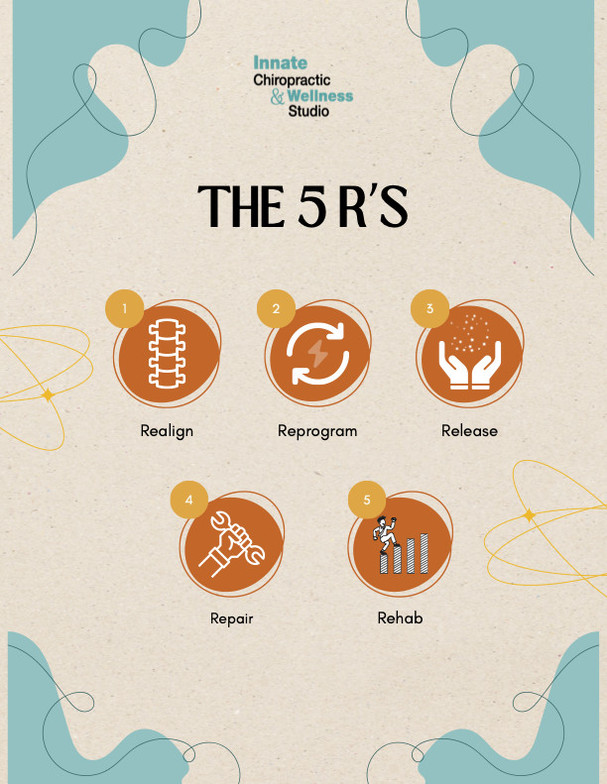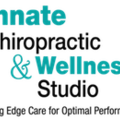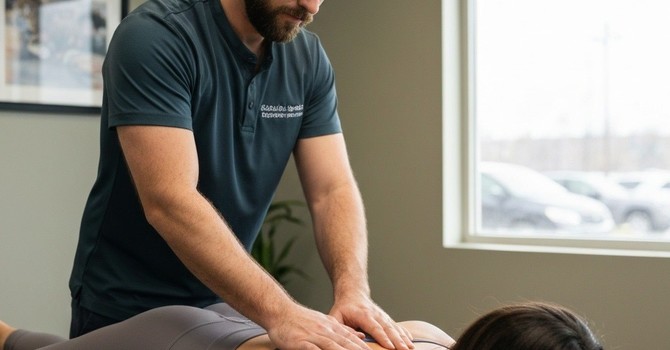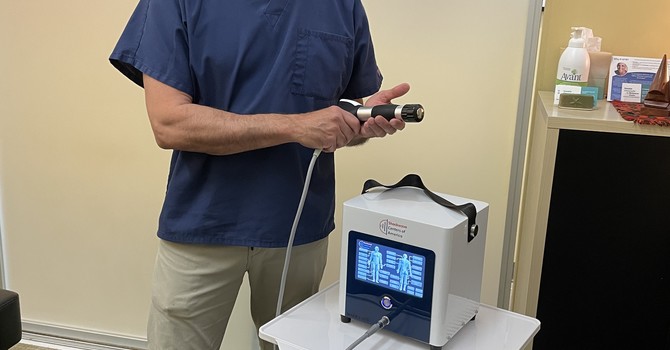
I have been in practice for 26 years as of this writing, and during this time I have studied many different techniques and approaches to care. When I am treating a patient, I pull from all these techniques as needed. There's a saying that you never cross the same river twice, and I find that to hold true in clinical practice as well. Yes, a broken bone doesn't go away overnight, but healing happens, and the body responds to stimuli. The brain via the nervous system constantly gets bombarded with feedback from all systems, all joints, all regions of fascia, and accordingly tells the body how to function. I am here to help if the messaging or patterning is garbled or being disrupted.
Accordingly, I have devised a 5-step approach which I have found to be comprehensive and effective. I call it the 5 R's. What are these R's? Let's go through them now.
1. Realign: The first tenet in chiropractic is to remove interference to the nervous system so that the body can work optimally. The nervous system can be disrupted by many things, but first and foremost is the vertebral subluxation. The spinal cord is a continuation of the brain and flows through the canal within the spinal column. From both sides of every vertebra come nerve roots, which in turn branch - one goes to an organ and one to a muscle. So thus there is an organ-muscle-vertebral relationship. When there is either a physical trauma or an overload in the body system, the vertebra can go out of alignment. I think of it like a circuit breaker. By identifying and correcting this misalignment, a lot of things can be normalized and corrected.
In addition to the 24 bones of the spine, there are the joints of the upper and lower extremities and the cranium. The same holds trye for these. So first and foremost, I check and correct allignment.
2. Reprogram: The next step is to normalize the muscles which get either too tight or too loose, thus pulling a joint out of alignment. Think of muscles like ropes attaching to a draw-bridge. Pull the muscle and the bone it's attached to moves. This analogy is basic but it holds up.
However, I've chosen to put the actual muscle work in step 3 (Release) because I've found that it's the nervous system telling the muscle to over or under fire that is the problem. Think of the wall switch vs the lightbulb. A flickering light may not mean a bad bulb but more likely a short circuit.
I use primarily PDTR (Proprioceptive Deep Tissue Reflex technique) to do this. I also use NET (Neuroemotional technique) if I find there's a mind-body or stress-physiology issue. Look for my other blogs where I discuss these amazing techniques in more detail.
3. Release: Once I've realigned and neurologically normalized a body region, I can now address the soft tissue itself. When I say soft tissue, I may be dealing with tight muscle. I may also be working with scar tissue or other adhesions in the muscle or the covering over the muscle called fascia. You can maybe think of fascia like the saran wrap covering a sausage. It connects whole systems of muscle together. Now picture two people (4 hands... 4 corners) holding up a sheet of saran wrap and a third person pinching and twisting a bit of it in the middle. A line of tension would form, and that is what I think of as an adhesion.
Traditionally in a clinic setting, we canuse various myofascial (muscle & fascial) release techniques such as:
- ART (Active Release Technique), where the muscle where there's an adhesion is held in place while the patient is instructed to stretch that muscle by moving that region to elongate the muscle.
- Graston or FAKTR or other such named beveled surgical metal tools that the doctor can scrape over the skin to help break down tight contractions and adhesions.
- Cupping, which uses (you got it!) plastic cups placed over an area of skin and then a pump removes air creating a vaccuum. This is the only decompressive tool we have, and it works great to release contracted muscles (it does leave red rings sometimes). I learned cupping technique at UCSF where they prefer to refer to it as Myofascial Decompression.
We have recently added a new system called Shockwave Therapy.
- Shockwave is a medical device which delivers blasts of sound (shockwaves) through the treatment head. Picture a large explosion where windows across the street or even miles away blow out. That is due to a large shockwave. These are very small, controlled shockwaves which travel through the skin pain free. but when they hit up against scar tissue or adhesions, it will feel uncomfortable or even "spicy." In this way, the application is both diagnostic (it tells us where the adhesions actually are) and therapeutic (if we stay over that area, the adhesions break down until it no longer hurts). The initial process using Shockwave promotes an initial inflammation stage of healing, followed by several processes listed in step 4 below.
4. Repair: Removing adhesions and scar tissue enables the body to flood the region with healing factors and hormones UEGF (vaso endothelial growth factor), ENOX (nitric oxide-producing hormone), BMP (bone stimulating growth hormone) and PCNA (proliferating cell nuclear antigen). Restoring proper communication and firing patterns (steps 1-3) is like removing a thorn - the region is still irritated but can now begin to heal.
5. Rehab: Ergonomics, posture and movement patterns are all really important to address and correct from day one. This is because movement patterns in everyday living reinforce themselves. That said, I come to find that actual rehab (lengthening & strengthening) should wait until muscle firing patterns and excessive adhesions & scar tissue are addressed. Otherwise you are stressing the body. There is a saying that if you have dysfunctional patterns and you try to work harder, you just get more dysfunction & compensation patterns. Going through the initial 4 steps first will optimize the outcome of any rehab & strengthening programs.
I hope this is helpful for you to better understand what makes my clinical approach different.






